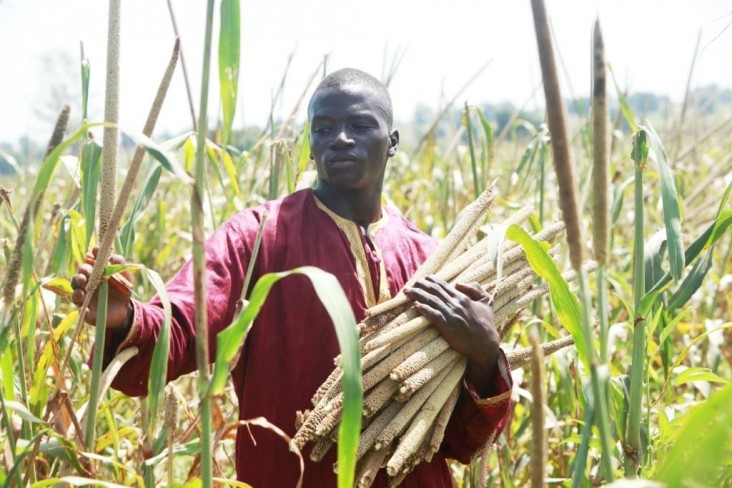
April 2015—Millet holds a prominent place in the agricultural sector of Paoskoto, in Senegal’s district of Nioro. But until recently, yields averaged just 500 to 600 kilograms per hectare due to unsustainable cultivation techniques and poor quality seeds.
USAID, through its Economic Growth Project, helped millet farmers in Paoskoto during the 2010-2011 crop year organize into networks to boost production and better integrate into market channels. Facilitators were trained to teach villagers about seed quality, conservation farming, organic fertilization, control of parasitic plants, grain quality standards required by industrial processors, and more.
In 2011, USAID helped a 50-member group of producers in two villages expand to form a network of 229 members covering 10 villages called Dekkal Mbeyum Souna, or Revitalizing Millet Cultivation. The results were immediate and clear, with unprecedented harvests and yields. According to Oumar Niasse, president of the group, average yields in the 2013-2014 season were 1.5 tons, with records of up to 3.3 tons per hectare.
As a result of the project, the traditional status of millet as basic subsistence crop has fundamentally changed. The farmers affiliated with the network reported that they could now meet their consumption needs for the entire year and also sell grain surpluses. With the additional income, millet growers are able to take care of other non-food expenditures.
“We are no longer faced with the problem of difficult hungry seasons,” Niasse explained, “and with the proceeds from the sale of surplus yields, we are able to cover medical costs for the family, to pay school fees for the children, purchase fertilizer for next season, and many of us can even afford the luxury of starting to build a real house.
“Now I take full advantage of my land, make it more profitable and earn a decent living, thanks to the agricultural technologies promoted by USAID in this region. I am serving my homeland better and serving myself better as well. I think that is the essence of local development, or of development, period.”
Despite these positive results, Dekkal Mbeyum Souna members are still affected by climatic stresses. Increasing instability of rainfall impacts their rain-fed maize and makes farmers vulnerable.
To help farmers cope with these risks and facilitate better access to credit from financial institutions, USAID collaborated with an agricultural insurance agency and an intermediation firm to provide rain index insurance. The goal is to help producers protect themselves against rainfall deficits that could have dire consequences for their livelihoods, especially since millet is the main staple of their diet.
For the 2014 rainy season, group members agreed to contribute their own funds to purchase an index insurance policy that covered nearly all 229 members, representing 271 of the 276 hectares sown for the season. When the rain started late as feared, members expected to receive compensation of about 30 percent of the crop value insured.
“We will be able to pay back our loans,” Niasse said, “which is critical to expand and continue what we have already accomplished.”
USAID’s Economic Growth Project, which runs from April 2009 to May 2015, aims to increase the agricultural sector's contribution to economic growth in Senegal through an inclusive value chain approach driven by the private sector. The focus is on improving productivity and quality as well as connecting small producers to urban and rural markets. In the 2014-2015 crop year, more than 2,600 small producers across the intervention area in the regions of Kaolack and Kaffrine have marketed 650 tons of quality millet.
LINKS
Follow @usaidafrica, on Facebook, on Flickr, on YouTube







Comment
Make a general inquiry or suggest an improvement.